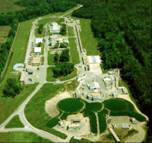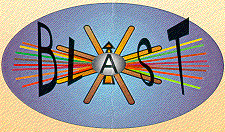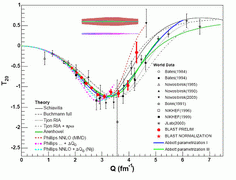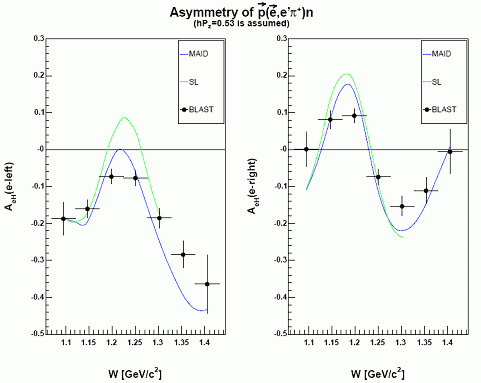LNS/NIG
Nuclear Interaction Group - Previous Research Programs - 1995 ~ 2009
| Jefferson Lab | BATES | Mainz |
JLab Physics
 |
From as far back as the conceptual statges of JLab, the NIG group has contributed and is continuously contributing to it in various ways. We have enriched its physics program by proposing many experiments in Halls A and B. Our Ph.D. students have participated numerous experiments in all three Halls and have completed their theses based on the data they have collected, and many of them have become leading physicists in their post-graduate career. We have also made major contribution to the hardware and software development of Hall A ands C since their early years. |
Experiments proposed by NIG members and completed by 2009
Experiments in Hall A
 Ph.D. Theses Experiments
Ph.D. Theses Experiments- We performed the first Hall-A experiment, E89-003. And these first data of Hall A have become the theses of two of our former Ph.D. students, Juncai Gao and Nilanga Liyanage.
- E89-044
was completed in March 2000, and has become the thesis of Marat Rvachev.
- E91-011
on pion production was completed in July 2000, and has become the thesis
of Zhengwei Chai.
- A precision measurement of the neutron spin structure, E99-117, was completed in August 2001 and was the thesis topic of Xiaochao Zheng, who also won the JLab thesis prize due to this work.
- Our student, Yi Qiang, has performed the best resolution, most precise and most extensive search to date of 3 pentaquark partners of the Theta+, experiment E04-012 at Hall A in 2005, and finished his thesis on this topic.
- Our student, Peter Monaghan, has completed in 2005 his experiment aimed at studying the short-distance behavior in nuclei by using the triple-coincidence 12C(e,e'pp) and 12C(e,e'pn) reactions E01-015.
- A high precision measurement of the proton elastic form
factor ratio pGEp/GMp,
E08-007, was performed using Hall A recoil polarimetry in May 2008
and has become the thesis of Xiaohui Zhan.
 Other experiments
Other experiments- E89-033: Measurement of Recoil Polarization in the 16O
Reaction with 4 GeV Electrons
- E91-026:
Measurement of the Electric and Magnetic
Structure Functions of the Deuteron at Large Momentum Transfers
-
E93-050: Virtual Compton Scattering
- HAPPEX expeirments, measurement of the parity violating asymmetries in e-p and e-4He elastic scattering and strangeness content of the nucleon.
- E93-027:
Measurement of the Electric Form Factor of the Proton by Recoil
Polarization
Experiments in Hall-B
- E91-023, Measurement of the GDH sum rule on the proton, was completed during CLAS eg1 running period. It was the thesis experiment of Alex Skabelin.
- E89-027, Searching for Short Range Correlations Using (e,e'NN) Reactions, was completed during CLAS e2 running period. It was the thesis experiment of Bin Zhang.
- In addition to providing leadership in the pursuit of
particular
physics and analysis goals, the NIG also performs general service work
for the collaboration's efforts.
Experiments in Hall-C
- E97-106 - Study of the Small Inter-Nuclear Distance Structure via the (e,e'pN) Reaction.
- Our student, Andrew Puckett, successfully ran experiments
E04-108
and
E04-019 in experimental Hall C at year 2008. Both experiments measured
the proton electric-magnetic form factor ratio using the recoil
polarization technique. Andrew finished his thesis on the experiment
E04-108,
which won him the
JLab thesis prize in year 2010.
MIT - BATES LINEAR ACCELERATOR CENTER
The Out-Of-Plane spectrometer (OOPS) system and its physics program
 The OOPS system allows
detection of the final state particles from a scattering process
outside the scattering plane. Hence, it allows extraction of the reaction
cross section with more degrees of freedom than typical in-plane
spectrometers. The OOPS is also complementary to typical large solid
angle devices
such as the BLAST
detector at Bates and the CLAS detector in JLab Hall-B because it is
designed to measure small effects with relatively high luminosity and
consequently low statistical accuracy.
There are now several OOPS
experiments which have been approved by the Bates PAC with high
scientific grades, three(3) of which have NIG member(s) as
spokespersons. Practically, we play a central role in all other
experiments and it is fair to say that our group is a leading player
in the entire OOPS program. The physics of these experiments fall into
four categories:
The OOPS system allows
detection of the final state particles from a scattering process
outside the scattering plane. Hence, it allows extraction of the reaction
cross section with more degrees of freedom than typical in-plane
spectrometers. The OOPS is also complementary to typical large solid
angle devices
such as the BLAST
detector at Bates and the CLAS detector in JLab Hall-B because it is
designed to measure small effects with relatively high luminosity and
consequently low statistical accuracy.
There are now several OOPS
experiments which have been approved by the Bates PAC with high
scientific grades, three(3) of which have NIG member(s) as
spokespersons. Practically, we play a central role in all other
experiments and it is fair to say that our group is a leading player
in the entire OOPS program. The physics of these experiments fall into
four categories: Studies of the Quadrupole
Component in the N -> Delta Transition:
Studies of the Quadrupole
Component in the N -> Delta Transition:E87-09-1H, E97-05-1H, E97-04-1H.
 Studies of the
Electromagnetic Currents in Deuterium:
Studies of the
Electromagnetic Currents in Deuterium:E89-14-2H n in various kinematics regions
E89-10-2H n on the quasi-elastic peak.
 Studies of the
Generalized Polarizabilities of the Proton via Virtual Compton
Scattering:
Studies of the
Generalized Polarizabilities of the Proton via Virtual Compton
Scattering:E97-03-1H.
 Studies of Few-Nucleon
Systems:
Studies of Few-Nucleon
Systems:
E97-06, E97-01-4He 3H.
To be specific, the entire year of 2004 was devoted to data taking with the BLAST detector.
 |
|
|

|

